There is a lot of research going on in Teagasc and much of this is focused on tackling climate change and the biodiversity crisis.
From reducing methane emissions to storing carbon in hedgerows, Teagasc researchers describe their work across these pages.
Irish products generating promising results in reducing methane emissions
Agriculture is responsible for 37% of Ireland’s greenhouse gas (GHG) emissions, with methane accounting for 68% of Irish agriculture’s GHGs. Reducing methane emissions is recognised as the quickest way to slow down the impact of climate change. Ireland has committed to reduce agricultural GHG emissions by 25% by 2030.
In Ireland, approximately 93% of methane emissions are derived from the digestion of feed in cattle and sheep and gaseous emissions from stored slurry. GlasPort Bio, a Galway-based company, has developed solutions to this.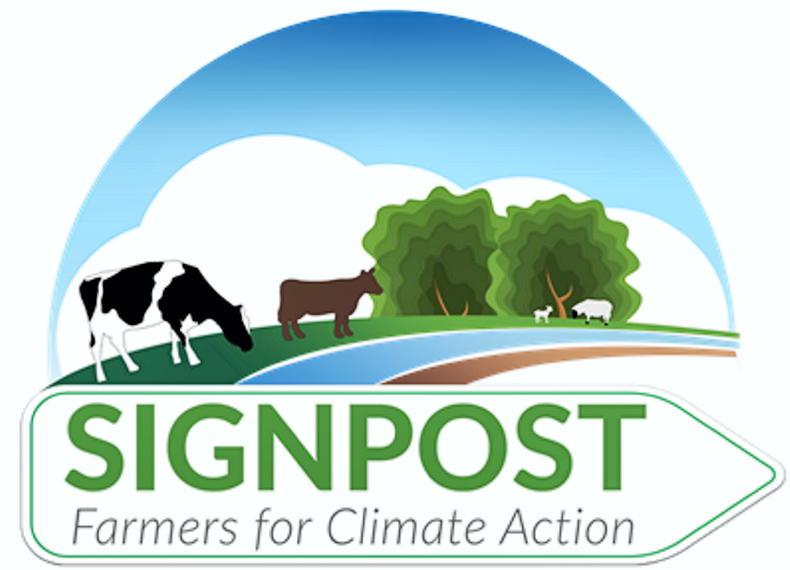
GasAbate, an additive added to stored slurry, can reduce methane emissions from slurry by greater than 80%, while also reducing other harmful gas emissions such as ammonia and hydrogen sulphide.
Treated slurry becomes a more effective fertiliser, allowing farmers to reduce spend on chemical fertiliser. GasAbate also greatly improves biogas yields when used in anaerobic digestion.
The company has also developed RumenGlas, a feed additive that can greatly reduce methane emissions from livestock.
In trials conducted in Teagasc Grange, preliminary results suggest methane emissions reductions of 30%, while allowing for dramatic increases in animal performance – with finishing cattle receiving RumenGlas having a 19% increase in daily weight gain. A benefit to this feed additive is that it can be delivered in a pelleted concentrate formulation.
Reducing nitrogen
loss from tillage
The Agricultural Catchments Programme has provided an update on catch crop research.
All farming sectors have to reduce nitrogen (N) loss, in order to restore water quality in all water bodies to a good status by 2027. On free draining, nitrate leaching-prone sites, research has shown that overwinter green cover can substantially reduce nitrate leaching to ground water from fallow crop land.

The phacelia, vetch and clover mix sown 2 September which to date is yielding 60% less than that sown two weeks earlier at the demonstration site.
The Agricultural Catchments Programme has been monitoring a tillage dominant river catchment in Castledockrell, Co Wexford, since 2008 and has been focusing on winter green cover research. Ireland’s fifth Nitrates Action Programme (NAP) requires in all circumstances that 75-80% of harvested crops be shallow cultivated or sown with a crop within 14 days of harvest. The earlier the green cover is established, the more N it can capture.
In 2021, four on-farm sown catch crops were selected with a range of sowing dates for sampling. Table 1 details the sowing dates and preceding agronomic detail. All crops were rape/leafy turnip.
Crop samples were taken for dry matter yield determination. The August-sown crops yielded much more than the September-sown crops through the sampling period.
As a follow on, this year a study is under way comparing the effect of four cover crop treatments on nitrate leaching, crop yield, crop N and soil fertility.
Natural cover regeneration. Shallow cultivation and natural regeneration. Shallow cultivation with leafy turnip and forage rape. Shallow cultivation with phacelia and vetch.
As part of the NAP, farmers must leave 20-25% of their stubble ground uncultivated for overwintering birds. This year, we have begun sampling seed, an important food source for birds, in uncultivated, shallow cultivated and sown catch crop ground on farms to track seed food source for wild birds over the winter period.
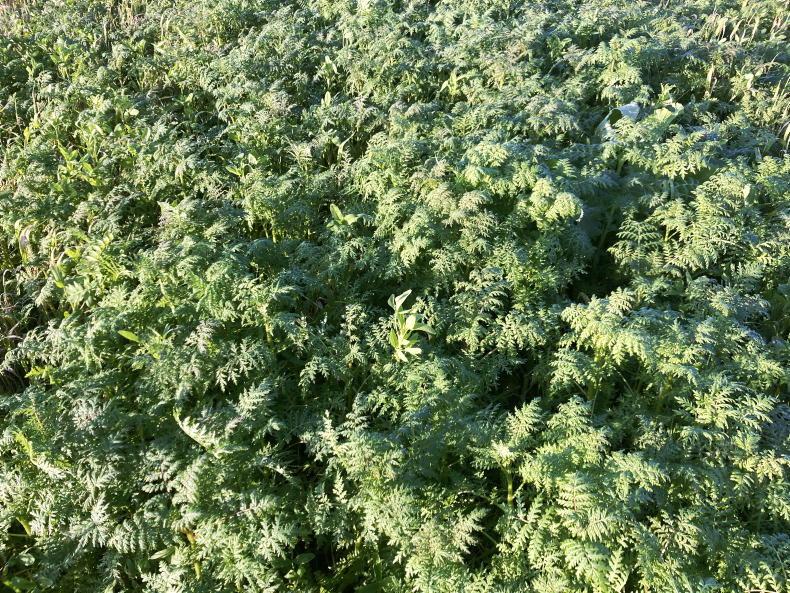
The phacelia, vetch and clover mix sown 19 August.
To complement this work, a knowledge transfer campaign on catch crops is underway, with a field scale demonstration site to be the focal point for tillage discussion groups this winter.
The site will demonstrate the effect of sowing date (19 August/2 September), post-sowing rolling (with or without) and mixture type:
Leafy turnip and forage rape. Radish, mustard, vetch, clover, forage rape, phacelia and linseed. Phacelia, vetch and clover.Sequestering and storing carbon in hedgerows
Dr Lilian O’Sullivan reports on the work being carried out across the country, examining hedgerows and their ability to store carbon. Hedgerows have important benefits in agricultural landscapes.
Along with acting as field boundaries, hedgerows provide animals with shelter, support flood control, and are widely known for their importance for biodiversity.
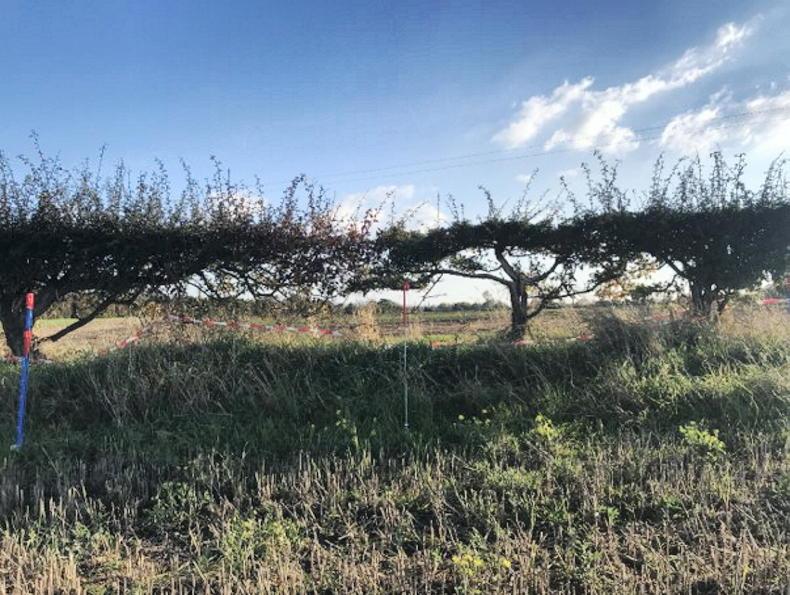
Figure 2. Over-managed older gappy hedgerow
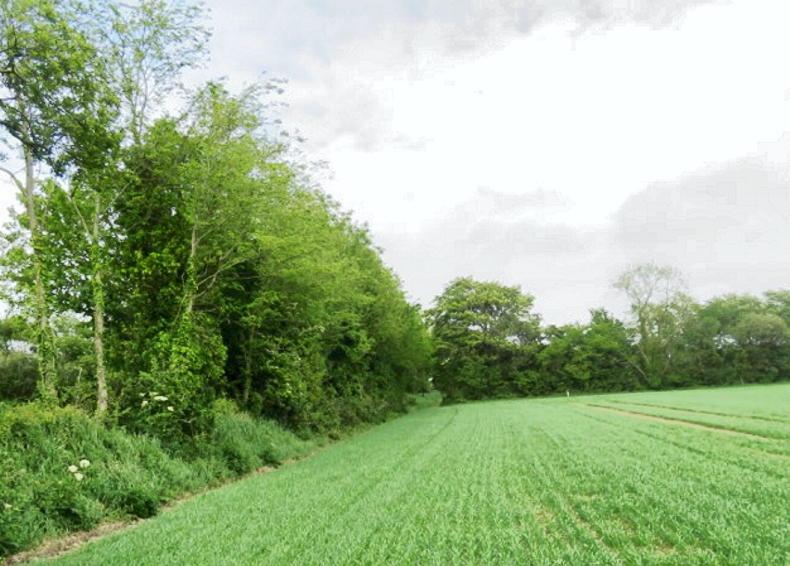
A less intensively managed hedgerow.
Increasingly though, farmers are interested in the carbon stock and sequestration potential of hedgerows and to see hedgerows accounted for in national inventories for greenhouse gases.
The challenge
To account for hedgerows in inventories, it is necessary to know the extent of hedgerows, their size and the type with respect to management. In addition, a mechanism to assess carbon stock change over time is needed.
Since 2010, Teagasc has been researching hedgerows to estimate national hedgerow stock and the carbon sequestration figure.
The BRIAR project estimated that there are 689,000km of hedgerow or 186,000ha in Ireland, taking an average width.
In the Farm Carbon project, direct hedgerow measurements were taken so that remote measurements can now be related to biomass and carbon stock.
What did we find?
Hedgerow management directly affects the amount of carbon that is sequestered or stored over time. Two main hedgerow types can be found. Intensively managed hedgerows that have limited benefits for carbon or biodiversity, and less intensively managed, wider, taller hedgerows that are managed on a cycle that contain significantly higher amounts of carbon.
An average across all hedgerows assessed indicated average above ground biomass stocks of approximately 58t of carbon per hectare.
What does this mean?
At national scale, if hedgerow removals exceed the carbon accumulated in newly established or growing hedgerows, then hedgerows can be reflected as a source of emissions.
While new hedgerow planting offers the best carbon sequestration potential, allowing hedgerows to grow out 1m either side and upward increases sequestration by 1-2t of carbon/ha per year.
What is the opportunity?
Hedgerow management that promotes rejuvenation of older hedges and less intensive management or planting of new hedgerows can enhance the carbon sequestration of hedgerows on your farm.
Reducing GHG emissions in
sheep systems
There are many steps that people can take on sheep farms across the country to reduce their carbon emissions, including optimising soil fertility, improving grassland management, increasing flock productivity, reducing days to slaughter and incorporating white clover into grazing swards.
Research at Teagasc is looking into the effects of animal production on methane output, with the aim to improve overall farm efficiency. Currently, the average GHG intensity of a lowland sheep farm is 10.6kg CO2eq/kg liveweight, with methane making up 66% of this.
In Teagasc research, portable accumulation chambers are being used to measure methane from sheep, with over 10,500 records of methane output collected to-date. Methane output is a heritable trait, meaning the trait is under genetic control and can be passed from one generation to the next. Therefore, work is underway to develop a breeding sub-index for methane output in conjunction with Sheep Ireland.
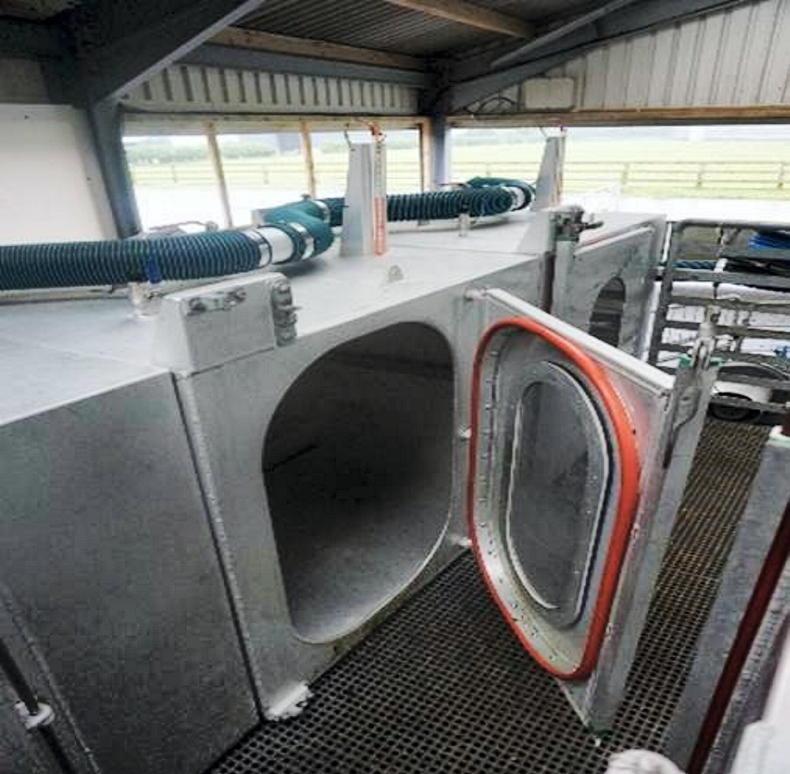
Sheep chamber.
To date, research carried out at Teagasc shows the potential for breeding a more sustainable animal, with animals ranked as five-star on the Sheep Ireland €uro-star index producing 7% less GHG per unit of output (i.e carcase weight).
From a sward perspective, when the methane output of animals grazing swards incorporating white clover, red clover or plantain was investigated, they ranked on average 12% lower than those grazing perennial ryegrass only swards.
There is a lot of research going on in Teagasc and much of this is focused on tackling climate change and the biodiversity crisis.
From reducing methane emissions to storing carbon in hedgerows, Teagasc researchers describe their work across these pages.
Irish products generating promising results in reducing methane emissions
Agriculture is responsible for 37% of Ireland’s greenhouse gas (GHG) emissions, with methane accounting for 68% of Irish agriculture’s GHGs. Reducing methane emissions is recognised as the quickest way to slow down the impact of climate change. Ireland has committed to reduce agricultural GHG emissions by 25% by 2030.
In Ireland, approximately 93% of methane emissions are derived from the digestion of feed in cattle and sheep and gaseous emissions from stored slurry. GlasPort Bio, a Galway-based company, has developed solutions to this.
GasAbate, an additive added to stored slurry, can reduce methane emissions from slurry by greater than 80%, while also reducing other harmful gas emissions such as ammonia and hydrogen sulphide.
Treated slurry becomes a more effective fertiliser, allowing farmers to reduce spend on chemical fertiliser. GasAbate also greatly improves biogas yields when used in anaerobic digestion.
The company has also developed RumenGlas, a feed additive that can greatly reduce methane emissions from livestock.
In trials conducted in Teagasc Grange, preliminary results suggest methane emissions reductions of 30%, while allowing for dramatic increases in animal performance – with finishing cattle receiving RumenGlas having a 19% increase in daily weight gain. A benefit to this feed additive is that it can be delivered in a pelleted concentrate formulation.
Reducing nitrogen
loss from tillage
The Agricultural Catchments Programme has provided an update on catch crop research.
All farming sectors have to reduce nitrogen (N) loss, in order to restore water quality in all water bodies to a good status by 2027. On free draining, nitrate leaching-prone sites, research has shown that overwinter green cover can substantially reduce nitrate leaching to ground water from fallow crop land.

The phacelia, vetch and clover mix sown 2 September which to date is yielding 60% less than that sown two weeks earlier at the demonstration site.
The Agricultural Catchments Programme has been monitoring a tillage dominant river catchment in Castledockrell, Co Wexford, since 2008 and has been focusing on winter green cover research. Ireland’s fifth Nitrates Action Programme (NAP) requires in all circumstances that 75-80% of harvested crops be shallow cultivated or sown with a crop within 14 days of harvest. The earlier the green cover is established, the more N it can capture.
In 2021, four on-farm sown catch crops were selected with a range of sowing dates for sampling. Table 1 details the sowing dates and preceding agronomic detail. All crops were rape/leafy turnip.
Crop samples were taken for dry matter yield determination. The August-sown crops yielded much more than the September-sown crops through the sampling period.
As a follow on, this year a study is under way comparing the effect of four cover crop treatments on nitrate leaching, crop yield, crop N and soil fertility.
Natural cover regeneration. Shallow cultivation and natural regeneration. Shallow cultivation with leafy turnip and forage rape. Shallow cultivation with phacelia and vetch.
As part of the NAP, farmers must leave 20-25% of their stubble ground uncultivated for overwintering birds. This year, we have begun sampling seed, an important food source for birds, in uncultivated, shallow cultivated and sown catch crop ground on farms to track seed food source for wild birds over the winter period.

The phacelia, vetch and clover mix sown 19 August.
To complement this work, a knowledge transfer campaign on catch crops is underway, with a field scale demonstration site to be the focal point for tillage discussion groups this winter.
The site will demonstrate the effect of sowing date (19 August/2 September), post-sowing rolling (with or without) and mixture type:
Leafy turnip and forage rape. Radish, mustard, vetch, clover, forage rape, phacelia and linseed. Phacelia, vetch and clover.Sequestering and storing carbon in hedgerows
Dr Lilian O’Sullivan reports on the work being carried out across the country, examining hedgerows and their ability to store carbon. Hedgerows have important benefits in agricultural landscapes.
Along with acting as field boundaries, hedgerows provide animals with shelter, support flood control, and are widely known for their importance for biodiversity.

Figure 2. Over-managed older gappy hedgerow

A less intensively managed hedgerow.
Increasingly though, farmers are interested in the carbon stock and sequestration potential of hedgerows and to see hedgerows accounted for in national inventories for greenhouse gases.
The challenge
To account for hedgerows in inventories, it is necessary to know the extent of hedgerows, their size and the type with respect to management. In addition, a mechanism to assess carbon stock change over time is needed.
Since 2010, Teagasc has been researching hedgerows to estimate national hedgerow stock and the carbon sequestration figure.
The BRIAR project estimated that there are 689,000km of hedgerow or 186,000ha in Ireland, taking an average width.
In the Farm Carbon project, direct hedgerow measurements were taken so that remote measurements can now be related to biomass and carbon stock.
What did we find?
Hedgerow management directly affects the amount of carbon that is sequestered or stored over time. Two main hedgerow types can be found. Intensively managed hedgerows that have limited benefits for carbon or biodiversity, and less intensively managed, wider, taller hedgerows that are managed on a cycle that contain significantly higher amounts of carbon.
An average across all hedgerows assessed indicated average above ground biomass stocks of approximately 58t of carbon per hectare.
What does this mean?
At national scale, if hedgerow removals exceed the carbon accumulated in newly established or growing hedgerows, then hedgerows can be reflected as a source of emissions.
While new hedgerow planting offers the best carbon sequestration potential, allowing hedgerows to grow out 1m either side and upward increases sequestration by 1-2t of carbon/ha per year.
What is the opportunity?
Hedgerow management that promotes rejuvenation of older hedges and less intensive management or planting of new hedgerows can enhance the carbon sequestration of hedgerows on your farm.
Reducing GHG emissions in
sheep systems
There are many steps that people can take on sheep farms across the country to reduce their carbon emissions, including optimising soil fertility, improving grassland management, increasing flock productivity, reducing days to slaughter and incorporating white clover into grazing swards.
Research at Teagasc is looking into the effects of animal production on methane output, with the aim to improve overall farm efficiency. Currently, the average GHG intensity of a lowland sheep farm is 10.6kg CO2eq/kg liveweight, with methane making up 66% of this.
In Teagasc research, portable accumulation chambers are being used to measure methane from sheep, with over 10,500 records of methane output collected to-date. Methane output is a heritable trait, meaning the trait is under genetic control and can be passed from one generation to the next. Therefore, work is underway to develop a breeding sub-index for methane output in conjunction with Sheep Ireland.

Sheep chamber.
To date, research carried out at Teagasc shows the potential for breeding a more sustainable animal, with animals ranked as five-star on the Sheep Ireland €uro-star index producing 7% less GHG per unit of output (i.e carcase weight).
From a sward perspective, when the methane output of animals grazing swards incorporating white clover, red clover or plantain was investigated, they ranked on average 12% lower than those grazing perennial ryegrass only swards.












 This is a subscriber-only article
This is a subscriber-only article










SHARING OPTIONS: